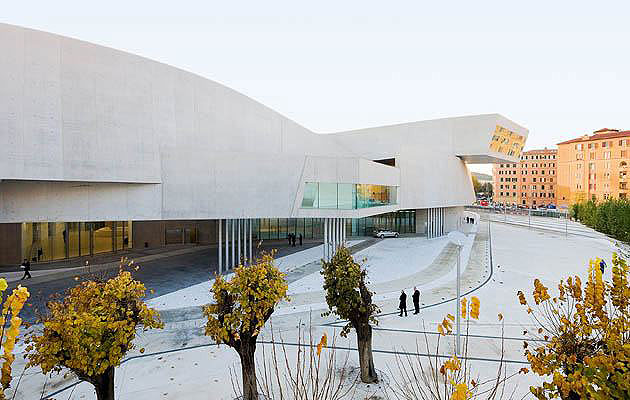|
|
||
|
Culture and education go head to head in this year’s Stirling prize shortlist as three museums weigh up against two exemplar schools, with a live-work building bravely waving the flag for smaller projects. With odds of 1/1, Zaha Hadid’s MAXXI Museum of Art in Rome is the bookies’ overwhelming favourite, and will be compared to David Chipperfield’s Neues Museum in Berlin and Rick Mather’s extension to the Ashmolean Museum in Oxford, three very different approaches to the cultural repository. Hadid’s voluptuous tendrils swoop into a dynamic infrastructural tangle, trumpeting the building as a piece of sculpture in its own right. As former icon editor, Justin McGuirk said in icon 079, MAXXI is “an impressive exercise in fluid space and should be enjoyed as a purely spatial experience, as architecture for its own sake”. But how has it fared since the paintings arrived? Chipperfield’s Neues Museum, meanwhile, stands as a charged ghostly backdrop to the artefacts on show, fusing the tumultuous history of the city and the history of museology in its sensitively restored fabric. As Edwin Heathcote argued in icon 070, “while the white cube and the icon fight it out for supremacy in art-world hype, the found space has always presented a richer background, a story against which a history can be told”. Mather’s Ashmolean extension provides a similarly complex story, a stacked interlocking puzzle of spaces that create a new flexibility in its deft composition. The inclusion of Christ’s College School in Guildford, by DSDHA, and dRMM’s Clapham Manor Primary School, comes as a welcome rebuke to the recently slashed budgets for such progressive educational projects. As RIBA President, Ruth Reed, commented, “they represent what all schools should be: light, well-laid-out and well-equipped environments in which all students can flourish,” adding that “it could be some time before we see such exemplar school buildings on the Stirling shortlist again”. DSDHA combine urban sensitivity with robust pragmatism on their campus site, the school’s brick shell enveloping a series of carefully arranged social spaces, with its central atrium providing a strong social hub for the 700 pupils. “It has created a different atmosphere,” says one Sixth Form student. “Everyone has a better attitude to work and has a lot more respect for things inside the school, and for each other.” Meanwhile, dRMM bring a technocratic approach to fresh air and light for an extension to a Victorian board school building. Their dramatic multicoloured box provides a vibrant new addition, its polychrome curtain walling creating a variegated skin for the double- and triple-aspect classrooms within. Finally, combining homes, an office and a gallery, Theis and Khan’s Bateman’s Row building is the surprising final contender and outsider at 7/1. “A boundary-pushing take on the future of mixed-use buildings,” in the words of Ruth Reed, it has unexpectedly knocked off the more established contenders Caruso St John’s Nottingham Contemporary gallery and Tony Fretton’s Warsaw Embassy. Whichever the winner, as vast cultural institutions prepare to fight it out with feisty progressive schools, we should enjoy it while it lasts: it may be the last of such buildings for a while.
Neues Museum, Berlin, by David Chipperfield Architects (image: Friederike von Rauch)
Ashmolean Museum, Oxford, by Rick Mather Architects (image: © Richard Bryant/Arcaid
Clapham Manor Primary School by dRMM (image: © Jonas Lencer)
Christ’s College School, Guildford, by DSDHA (image: © Hélène Binet)
Bateman’s Row, London, by Theis and Khan Architects (image: © Nick Kane) |
Words Oliver Wainwright |
|
|
||



















